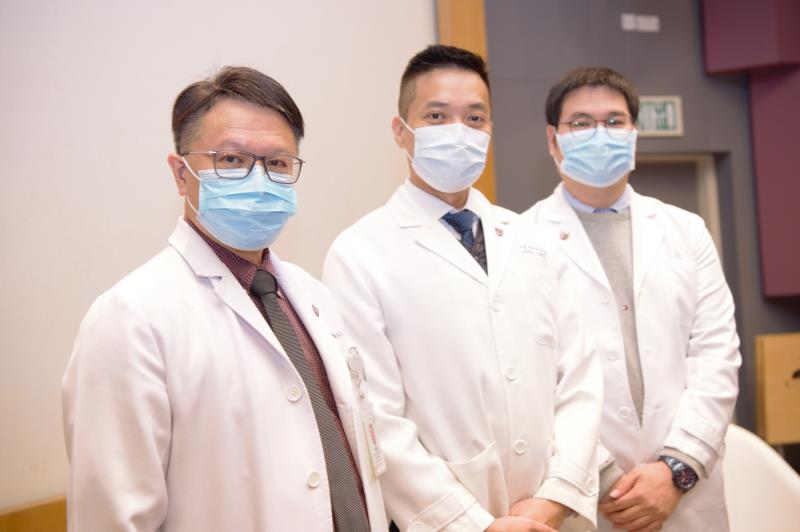 Prof David Hui (left), Prof Samuel Wong (middle), Dr Kin-On Kwok (right) (Photo credit: CUHK)
Prof David Hui (left), Prof Samuel Wong (middle), Dr Kin-On Kwok (right) (Photo credit: CUHK)An epidemiological study of the first 56 cases of coronavirus disease 2019 (COVID-19) confirmed in Hong Kong reveals a containment delay of 6.5 days from first symptom onset to patient isolation, with a longer containment delay among local vs imported cases.
Of note, the patients had sought multiple medical consultations prior to COVID-19 diagnosis, with some patients hospitalized for up to 8 days prior to isolation, highlighting an increased risk of transmission to close contacts and within hospitals.
In the study, researchers from the Chinese University of Hong Kong (CUHK) analyzed COVID-19 cases in Hong Kong using data from the Department of Health’s Centre for Health Protection (CHP). Among the 56 cases confirmed between 23 January 2020 and 15 February 2020, 13 were imported (mean age, 57.3 years; 69 percent male), while 43 were local (mean age, 55.4 years; 49 percent male).
“The duration of containment delay was longer for the local cases, at 7.62 days, compared with 1.7 days for the imported cases,” reported investigator Dr Kin-On Kwok of the Jockey Club School of Public Health and Primary Care, CUHK.
While the average duration of containment delay was 6.5 days for all cases analyzed, a containment delay of 14 days was found in one of the cases. In addition, a trend of increased containment delay was observed in the more recent cases.
“The duration of containment delay increased from 2 days for patients isolated on 21–28 January 2020, to 5.31 days for those isolated between 29 January 2020 and 5 February 2020, and to 7.22 days for those isolated on 6–12 February 2020. Cases confirmed and isolated from the end of January onwards were mostly local,” said Kwok.
“Before COVID-19 was diagnosed, the patients had sought a median of three consultations from private doctors, private hospitals or public hospitals,” he continued. “Age, sex and comorbidities were not significantly associated with the number of consultations sought.”
“Of note, three patients had been hospitalized for 4–8 days prior to isolation, highlighting a potentially increased risk of nosocomial transmission,” he said.
“The duration of containment delay found in our study is similar to that reported in mainland China. As the viral load of patients with COVID-19 peaks on days 2–3 after illness onset, the risk of outbreak among close contacts in the community appears to be larger than that in hospitals,” said Professor David Hui of the Department of Medicine and Therapeutics, CUHK. [N Engl J Med 2020, doi: 10.1056/NEJMc2001737]
Although the basic reproduction number (R0) of 0.319 in the current cohort indicates a low likelihood of a sustained outbreak, Kwok urged caution due to the recent cluster of local cases and the delayed diagnosis found in the study.
“As the number of consultations sought is linked to the duration of containment delay, doctors may ask patients with respiratory symptoms about the frequency and details of medical consultations sought in the last 14 days, and refer those at risk of having COVID-19 to public hospitals,” suggested Kwok.
“For patients with persistent fever, complete blood count is a useful test in the general practice setting because leucopenia with lymphopenia would be a sign of viral pneumonia,” Hui advised.
“As for treatment of COVID-19, a clinical trial of remdesivir vs supportive care, with 28 days of follow-up, will complete recruitment in Hubei, China, later this week,” said Hui.
Social distancing measures inadequately adopted
The CUHK researchers also surveyed 1,168 adult residents of Hong Kong between 24 January 2020 and 5 February 2020 to evaluate their risk perception of and psychobehavioural responses to the COVID-19 outbreak.
Results showed high levels of perceived susceptibility (88 percent) to and perceived severity (98 percent) of COVID-19. “The respondents’ anxiety level was borderline abnormal, with a mean Hospital Anxiety and Depression Scale [HADS-A] score of 8.82,” reported Professor Samuel Wong of CUHK’s Jockey Club School of Public Health and Primary Care.
While 95.4–98.7 percent of the respondents adopted enhanced personal hygiene measures, social distancing measures were less adopted (28.6–92.2 percent) despite their perceived value (68.8–97.3 percent) in COVID-19 prevention.
“In particular, only 56.3 percent of respondents avoided social activities,” noted Wong.
“Most recent cases of COVID-19 were transmitted through close social contact. If more cases with unknown sources are identified in Hong Kong, the government may have to consider more drastic social distancing approaches, including the closure of shopping malls and suspension of public services,” suggested Kwok.